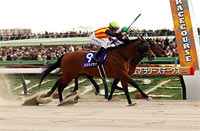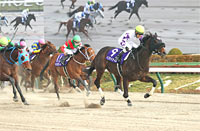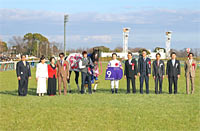February Stakes (G1) - Data Analysis
First G1 race of 2022 is dirt champion decider
The February Stakes, which was established in 1984 as a G3 dirt handicap race contested over a distance of 1,600m at Tokyo Racecourse, was upgraded to G1 status in 1997. Since then, the race has been won by a long line of horses that have etched their names in the JRA dirt racing history. Being the first JRA G1 contest of the year and an indicator of trends in the 2022 dirt races, how will the race play out? Let’s now look at the data for the last 10 years and explore the features of successful runners.
High success ratios for runners that have finished in Top 2 of previous race
There has been a large gap in success ratios between runners that had finished in the Top 2 of their previous race, and those that had been beaten to 3rd or lower. Looking back at the data for the last 10 years, 2021 was the only year in which runners in the former group did not enter the Top 2 of the February Stakes. We should therefore think of last year as an anomaly, and mainly pick runners that have finished in the Top 2 last time out. [Table 1]
[Table 1] Performance by finish in previous race (last 10 years)
| Finish in previous race |
Performance
[1st-2nd-3rd-4th or lower] |
Win ratio |
Top 2 ratio |
Top 3 ratio |
| Top 2 |
6-6-7-40 |
10.2% |
20.3% |
32.2% |
| 3rd or lower |
4-4-3-88 |
4.0% |
8.1% |
11.1% |
Runners with final speed have the edge
The homestretch on the dirt course of Tokyo Racecourse is the longest of all JRA dirt courses, at 501.6m. As a result, the course tends to produce victories achieved through a good turn of foot on the homestretch. Looking at performances of runners by ranking in terms of their estimated time over the final three furlongs in their previous race, we find that success ratios diverged widely between runners that were ranked 3rd or higher and those that were ranked 4th or lower. Among the former group, those that had also triumphed in their previous race achieved excellent performance of [6-2-3-12] in the last 10 years. [Table 2]
[Table 2] Performance by ranking in terms of estimated time over final three furlongs last time out (last 10 years)
| Ranking |
Performance
[1st-2nd-3rd-4th or lower] |
Win ratio |
Top 2 ratio |
Top 3 ratio |
| 3rd or higher |
7-5-4-28 |
15.9% |
27.3% |
36.4% |
| 4th or lower |
3-1-3-68 |
4.0% |
5.3% |
9.3% |
Note: Runners that contested a NAR or overseas race last time out have been excluded.
Five major prep races
Looking at performances by runners over the last 10 years in terms of the previous race, we find that more than 10 runners in each February Stakes came from one of five prep races: the Negishi Stakes, the Tokai TV Hai Tokai Stakes, the Champions Cup, the Tokyo Daishoten, or the Kawasaki Kinen. Of the 30 Top 3 finishers, 28 had contested one of these five races last time out. In other words, we need to slightly discount runners that have previously contested another race. Additionally, since runners that had won one of these five races achieved an extremely high Top 3 ratio of 57.9%, those with such a profile should be regarded as top contenders. [Table 3]
[Table 3] Performance by major previous races (last 10 years)
| Previous race |
Performance
[1st-2nd-3rd-4th or lower] |
Win ratio |
Top 2 ratio |
Top 3 ratio |
| Negishi Stakes |
4-2-3-50 |
6.8% |
10.2% |
15.3% |
| Tokai Stakes |
3-1-1-15 |
15.0% |
20.0% |
25.0% |
| Champions Cup |
2-3-2-9 |
12.5% |
31.3% |
43.8% |
| Farewell Stakes |
1-0-0-0 |
100% |
100% |
100% |
| Tokyo Daishoten |
0-2-2-11 |
0% |
13.3% |
26.7% |
| Kawasaki Kinen |
0-2-1-12 |
0% |
13.3% |
20.0% |
| Musashino Stakes |
0-0-1-1 |
0% |
0% |
50.0% |
Note: Only races that produced Top 3 finishers in the February Stakes are shown.
Note: Champions Cup data includes races until 2013, when the race was held under the name “Japan Cup Dirt.”
Heavy horses fare well; success ratios even higher for runners with increase in weight from previous race
Over the last 10 years, horses that entered the February stakes with a weight of 500kg or more produced eight winners, compared with only two winners for runners with a weight of less than 500kg. It therefore appears that heavier horses fare well in this race, probably because additional power is required to perform well on the dry dirt course of the winter season. However, we should also note that success ratios drop significantly once horses reach a weight of 540kg or more. [Table 4]
[Table 4] Performance by body weight (last 10 years)
| Body weight |
Performance
[1st-2nd-3rd-4th or lower] |
Win ratio |
Top 2 ratio |
Top 3 ratio |
| 499kg or lower |
2-4-1-55 |
3.2% |
9.7% |
11.3% |
| 500-519kg |
3-3-4-36 |
6.5% |
13.0% |
21.7% |
| 520-539kg |
5-3-4-29 |
12.2% |
19.5% |
29.3% |
| 540kg or higher |
0-0-1-8 |
0% |
0% |
11.1% |
In addition, among horses that entered the race with a weight of 500kg or more, those that were heavier than in their previous race achieved an even higher Top 3 ratio of 34.1%. Strong performers in this group includes 2014 winner Copano Rickey, who was the 16th favorite (weight of 530kg, 4kg higher than in previous race), 2020 16th favorite and runner-up K T Brave (weight of 524 kg, 4kg higher than in previous race), and 2021 eighth favorite and third-place finisher Wonder Lider (weight of 534 kg, 2kg higher than in previous race). It is worth noting that poorly favored runners also performed well. [Table 5]
[Table 5] Among runners with a weight of 500kg or more, performance by change in body weight from previous race (last 10 years)
| Change in body weight |
Performance
[1st-2nd-3rd-4th or lower] |
Win ratio |
Top 2 ratio |
Top 3 ratio |
| Increase |
4-3-7-27 |
9.8% |
17.1% |
34.1% |
| No change |
1-1-1-14 |
5.9% |
11.8% |
17.6% |
| Decrease |
3-2-1-32 |
7.9% |
13.2% |
15.8% |
Focus on runners aged 4 to 6
Many runners aged 4, 5, and 6 have delivered strong performance over the last 10 years. Meanwhile, success ratios for those who were aged 7 and above have been slightly lower. Incidentally, runners in this group have also produced zero winners since 1997, the year in which the February Stakes was upgraded to G1 status. [Table 6]
[Table 6] Performance by age (last 10 years)
| Age |
Performance
[1st-2nd-3rd-4th or lower] |
Win ratio |
Top 2 ratio |
Top 3 ratio |
| 4 |
4-1-0-21 |
15.4% |
19.2% |
19.2% |
| 5 |
3-3-4-24 |
8.8% |
17.6% |
29.4% |
| 6 |
3-2-3-28 |
8.3% |
13.9% |
22.2% |
| 7 and above |
0-4-3-55 |
0% |
6.5% |
11.3% |
Seek out the winner!
Watch runners that have won a graded dirt race within the last year
As noted above, since it was upgraded to G1 status, the February Stakes has been won exclusively by runners aged 4 to 6. In addition, in the last 10 years, all winners had experience of triumphing in a 1,400-2,000m graded dirt race within the last year. When predicting the potential winner, we should definitely check the age of the runners and their performance in graded dirt races within the last year. [Table 7]
[Table 7] Winners’ age and win record in graded dirt races within the last year (last 10 years)
| Year |
Winner |
Age |
Win record in graded dirt races
within last year |
| 2012 |
Testa Matta |
6 |
March Stakes |
| 2013 |
Grape Brandy |
5 |
Tokai TV Hai Tokai Stakes |
| 2014 |
Copano Rickey |
4 |
Hyogo Championship |
| 2015 |
Copano Rickey |
5 |
February Stakes, etc. |
| 2016 |
Moanin |
4 |
Negishi Stakes |
| 2017 |
Gold Dream |
4 |
Unicorn Stakes |
| 2018 |
Nonkono Yume |
6 |
Negishi Stakes |
| 2019 |
Inti |
5 |
Tokai TV Hai Tokai Stakes |
| 2020 |
Mozu Ascot |
6 |
Negishi Stakes |
| 2021 |
Cafe Pharoah |
4 |
Sirius Stakes, etc. |
(Yodohito Himezono)
|



















